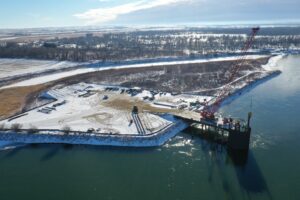9/20/23
About a month ago, Southern California was hit by Tropical Storm Hilary, the first tropical storm to land in California in 84 years. On August 20, 2023, San Diego had its wettest day on record and Palm Springs set a new record for most rain in a single day. The rain from the storm resulted in flooding, mudflows, sinkholes, and power outages across southern California.
Flooding is a natural disaster that can result in loss of life or property, damage infrastructure, facilities, and agriculture, and affect water and wastewater supply and treatment. When California was hit back in 1939 by a tropical storm, North Dakota was still experiencing a very different type of extreme weather: drought. All through the 1930s, North Dakota (and the rest of the Midwest) experienced drought with 1934 and 1936 both setting records for the driest year on record.
One of the ways extreme weather can be categorized is through frequency analysis. The term 100-year flood or 500-year flood might come to mind. This does not mean that an event like the one that just happened in California will only occur once every 10 or 500 years, but rather that the recurrence interval, or chance of it happening in a given year, is 1 in 100 (1%) or 1 in 500 (0.2%). This same idea can also be used to define droughts (chances of it occurring in a certain time frame); however, droughts tend to happen over longer periods when compared to floods. The amount (or lack) of water making up a 100-year flood (or drought) are what engineers use in their planning considerations and design calculations.
Engineers use these extreme weather events, such as the flood in California and the 1930’s drought in North Dakota, when they design flood mitigation or drought resiliency projects. Currently, the Burian and Associates team is part of the consulting team for the Red River Valley Water Supply Project (RRVWSP). When fully constructed, this project will deliver water from the Missouri River in the McClusky Canal via pipeline to the Sheyenne River for communities and rural water districts in central and eastern North Dakota to combat drought and support economic development. Through modeling efforts for the project, our team is using historical information across several climate indicators (including drought and flood years) to analyze water availability leading up to, during, and following drought years.
The RRVWSP is currently under construction and received generous funding support from the North Dakota Legislature in 2023. When completed, the RRVWSP will provide drought resiliency and support economic development for nearly half of the residents in North Dakota. The Burian and Associates Team is excited to be part of and lend their expertise to this very impactful project.



Sources:
Flood. (2023). Water.ca.gov; California Department of Water Resources. https://water.ca.gov/Water-Basics/Flood
Hilary live updates: Storm slams California with flash floods. (2023, August 21). NBC News. https://www.nbcnews.com/news/us-news/live-blog/hilary-live-updates-storm-california-rcna100908
Jones, D. (2023, August 18). Hilary could be the first tropical storm to hit California in more than 80 years. NPR. https://www.npr.org/2023/08/18/1194588117/hilary-could-be-the-first-tropical-storm-to-hit-california-in-more-than-80-years
Petri, A., Toohey, G., & Zahniser, D. (2023, August 21). Hilary leaves massive flooding, mudslides, upheaval across Southern California. Los Angeles Times. https://www.latimes.com/california/story/2023-08-21/hilary-moves-out-of-southern-california-leaving-massive-flooding
Robinson, E. (2017). Chapter 18. In History of North Dakota (pp. 396–416). Open Educational Resources.
Water Science School. (2018). The 100-Year Flood. USGS. https://www.usgs.gov/special-topics/water-science-school/science/100-year-flood
